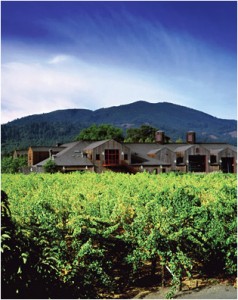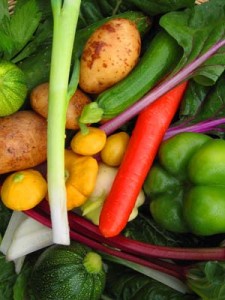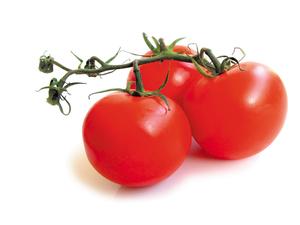USDA Offers Conservation Funding to Organic Producers
 Agriculture Deputy Secretary Kathleen Merrigan today announced USDA will provide funding to help organic producers and those transitioning to organic production implement resource conservation practices on their agricultural operations.
Agriculture Deputy Secretary Kathleen Merrigan today announced USDA will provide funding to help organic producers and those transitioning to organic production implement resource conservation practices on their agricultural operations.
“Increasing consumer demand for organically grown foods is providing new opportunities for small and mid-size farmers to prosper and stay competitive in today’s economy,” Merrigan said. “The 2008 Farm Bill calls for this assistance, and we want to help these farmers protect the natural resources on their land and create conditions that help foster organic production.”
Fiscal year (FY) 2011 marks the third year of USDA’s Organic Initiative, and up to $50 million is available this year for producers to plan and implement conservation practices that address natural resource concerns in ways that are consistent with organic production. For example, organic producers may use the funding to plant cover crops, establish integrated pest management plans, or implement nutrient management systems consistent with organic certification standards.
Eligible producers include those certified through USDA’s National Organic Program, those transitioning to certified organic production, and those who meet organic standards but are exempt from certification because their gross annual organic sales are less than $5,000. In FY 2010, NRCS obligated nearly $24 million through the Organic Initiative to help producers implement conservation practices.
Organic Initiative funding is provided through the Environmental Quality Incentives Program (EQIP), a voluntary conservation program administered by USDA’s Natural Resources Conservation Service (NRCS) that promotes agricultural production and environmental quality as compatible national goals. The 2008 Farm Bill provided for assistance specifically for organic farm operations and those converting to organic production.
Under Organic Initiative contracts, producers are paid 75 percent of the cost for the organic conservation measures they implement. Beginning, limited resource, and socially disadvantaged producers are paid 90 percent. The program provides up to $20,000 per year per person or legal entity, with a maximum total of $80,000 over six years.
Producers interested in applying for Organic Initiative funding must submit applications through their local NRCS Service Center, which can be located through the Web site at http://offices.sc.egov.usda.gov/locator/app?agency=nrcs. Applications are accepted on a continuous basis, with the cutoff date set for March 4, 2011.
NRCS is celebrating 75 years helping people help the land. Since 1935, the NRCS conservation delivery system has advanced a unique partnership with state and local governments and private landowners delivering conservation based on specific, local conservation needs, while accommodating state and national interests.
USDA Announces Organic Agriculture Research and Extension Projects
 WASHINGTON, Oct. 27, 2010 – USDA’s National Institute of Food and Agriculture (NIFA) today awarded 30 grants to enhance the ability of organic producers and processors grow and market high quality organic agricultural products.
WASHINGTON, Oct. 27, 2010 – USDA’s National Institute of Food and Agriculture (NIFA) today awarded 30 grants to enhance the ability of organic producers and processors grow and market high quality organic agricultural products.
“More and more farmers are adopting organic agriculture practices to produce quality food and boost farm income,” said Roger Beachy, director of USDA’s National Institute of Food and Agriculture (NIFA). “These research and extension projects will equip producers with the tools and resources they need to operate profitable and sustainable organic farms.”
NIFA awarded more than $18 million through the Organic Agriculture Research and Extension Initiative (OREI). Research at USDA increasingly focuses on the science that supports development of sustainable practices in agriculture and forestry, including organic farming, to both reduce negative impacts on the environment and keep U.S. farmers competitive. For more OREI information, visit www.nifa.usda.gov/fo/
organicagricultureresearchandextensioninitiative.cfm.
Additionally, more than $4 million was awarded through the Organic Transitions Program (ORG). In FY 2010, this program focused on environmental services provided by organic farming systems that support soil conservation and contribute to climate change mitigation. Practices and systems addressed include those associated with organic crops, organic animal production (including dairy) and organic systems integrating plant and animal production. More information on the program can be found online at www.nifa.usda.gov/fo/organictransitionsprogram.cfm.
Some U.S. producers are turning to certified organic farming systems as a potential way to lower input costs, decrease reliance on nonrenewable resources, capture high-value markets and premium prices and boost farm income. Since the late 1990s, U.S. organic production has seen heavy growth. Now, more than two-thirds of U.S. consumers buy organic products at least occasionally, and 28 percent buy organic products weekly.
Fiscal Year 2010 OREI awards include:
• University of Arizona, Tucson, Ariz., $2,907,334
• University of Georgia, Athens, Ga., $45,713
• University of Idaho, Moscow, Idaho, $108,815
• USDA-Agricultural Research Service, Peoria, Ill., $49,666
• Purdue University, West Lafayette, Ind., $1,288,010
• USDA-Agricultural Research Service, Ames, Iowa, $2,864,478
• University of Maryland, College Park, Md., $526,781
• Michigan State University, Lansing, Mich., $963,762
• Michigan State University, Lansing, Mich., $616,492
• University of Minnesota, Minneapolis, Minn., $1,273,250
• Farmers` Legal Action Group, Inc., St. Paul, Minn., $109,200
• University of New Hampshire, Durham, N.H., $31,372
• Oregon State University, Corvallis, Ore., $2,428,677
• South Dakota State University, Brookings, S.D., $43,809
• University of Tennessee, Knoxville, Tenn., $50,000
• Texas A&M University, College Station, Texas, $661,437
• USDA-Agricultural Research Service, College Station, Texas, $967,916
• Utah State University, Logan, Utah, $1,019,411
• University of Vermont, Burlington, Vt., $759,516
• Washington State University, Pullman, Wash., $1,538,115
• West Virginia University, Morgantown, W.V., $31,344
• University of Wisconsin, Madison, Wisc., $658,735
• University of Wisconsin, Madison, Wisc., $574,621
Fiscal Year 2010 ORG awards include:
• University of Florida, Gainesville, Fla., 624,148
• University of Illinois, Urbana, Ill., $649,883
• Iowa State University, Ames, Iowa, $691,969
• University of New Hampshire, Durham, N.H., $700,000
• North Carolina State University, Raleigh, N.C., 590,906
• Texas AgriLife Extension Service, College Station, Texas, $697,012
• University of Wyoming, Laramie, Wyo., $700,000
Through federal funding and leadership for research, education and extension programs, NIFA focuses on investing in science and solving critical issues impacting people’s daily lives and the nation’s future. More information is at: www.nifa.usda.gov.
Oregon Herb Company Smells Of Success
 by Rachael McDonald NPR: Listen September 21, 2010 from KLCC :What started out as a quirky little home-based, mail-order company more than 20 years ago is now the nation’s second-largest distributor of organic dried herbs. Mountain Rose Herbs has been growing and thriving, despite the recession.
by Rachael McDonald NPR: Listen September 21, 2010 from KLCC :What started out as a quirky little home-based, mail-order company more than 20 years ago is now the nation’s second-largest distributor of organic dried herbs. Mountain Rose Herbs has been growing and thriving, despite the recession.
On first encounter, it’s the company’s smell — not its success — that’s noteworthy. The company packages dried herbs, spices and essential oils and mails them out to more than one-quarter of a million customers. “If you can imagine the aroma of [700] to 800 different botanicals condensed into one overpowering cannonball,” says co-owner Shawn Donnille, “and it literally permeates clothing, fabric, fiber, paper, books — everything that we have in our offices here in our clothing.”
‘A Certain Moral Character’
Donnille wears a black T-shirt, black pants and black nonleather boots. His long hair hangs in a thin braid down his back. The tattooed former environmental activist is credited with much of the vision behind Mountain Rose’s success. But even he isn’t sure what the secret to its growth has been.”I don’t know how we pulled that one off. I really don’t. I mean, I have my suppositions,” he says. People are choosier about how to spend their money when times are tight, Donnille says, “and I think that in the last two years … we’ve earned their trust.” Mike Russo, a professor at the Lundquist College of Business at the University of Oregon in Eugene, agrees.
“There’s a certain moral character to the recession that we’ve been through, and so customers are looking for companies with which they can identify morally and philosophically,” he says, “and I think that that’s drawn a lot of customers to Mountain Rose.” Mountain Rose is serious about doing business differently. That difference shows up not only in their products, which are all certified organic by federal and state standards, but also in the way they treat their staff.
The company recently moved into a larger building in Eugene. Their customer service area buzzes with activity: Employees on headsets chat with customers and tap on computer keyboards. Starting pay here is 30 percent above Oregon’s minimum wage, around $11 an hour. That might not seem like much, but for Southern Oregon it’s pretty good. In addition, co-owners Donnille and Julie Bailey limit their incomes.
“We’ve capped our pay at 3.5 times entry-level pay, which is a fair and honest living for us, which is all we really want,” Donnille says.
The company is also zero-waste. They recycle nearly everything — even paper towels. Used paper towels go to a local industrial recycling facility. They also contribute $75,000 annually to local nonprofits.
Changing The Rules
A quirky business like Mountain Rose Herbs works well in a college town like Eugene, Russo says. “If you look around, there’s plenty of unusual companies that are able to do business in their own way. And so, to some extent, they can make their own rules,” he says.
And they’re making up rules that even fly in the face of the business mantra, “growth is good”. Donnille says the company has been growing too fast: 30 to 35 percent for the past several years. “It’s too much. It really is too much, and we’re trying to figure out a way to reach a more level state of homeostasis, where … the growth is stable. And we’re thinking that 15 percent might be good,” he says. Now, Mountain Rose Herbs has the challenge of maintaining its success without losing its unusual values.
Organic Wine from Chile That Is Worth Drinking
When I first tried a sampling of organic wine from California about a decade ago, it was all downright awful. At that time I felt like “Two Buck Chuck” from Trader Joe’s was a better option—at a fraction of the price. A few years ago I tried again, this time with a range of organic wines from Oregon. Better, but still inferior to regular wines from the same region, especially considering the higher price.
Some say that the more strict organic labeling requirements in the U.S. lead to an inferior product: they say that producing wine with no sulfites pretty much guarantees that the wine will have a poor shelf life and you’d better drink it very quickly. If not it will get progressively worse.
While touring through Chile recently, however, I discovered two wineries that appear to have crossed the threshold. The wines coming out of Matetic and Emiliana are consistently as good or better than those coming from vineyards using non-organic methods. You can drink these just because you like good wine: the eco-friendly part is a bonus.
Producing organic and biodynamic wine is not easy. Matatic and Emiliana both have herds of sheep roaming the grounds to chew up the grass and weeds between the vines and to provide natural fertilizer. The companies use solar energy and biofuels and are attempting to get certified as carbon-neutral. Keeping the bugs away requires more labor, though Chile’s topography means fewer pests than in the U.S. and Europe.
Matetic’s winery in the Rosario Valley employs a wide range of biodynamic principles, like being built into a hill to keep the temperature contstant and using gravity-fed hoses instead of pumps. In order to maintain diversity and give employees a stake in the business, Emiliana allows them to grow their own crops on company-owned land adjoining the vineyards (like olive trees for olive oil), with profits from these side projects going to the families directly. I was impressed by the results, the whole line from both wineries being on par with the quality found in other top Chilean wineries. Over and over in these wines I found a surprising level of complexity and variety. Emiliana’s red blend Coyam was heavenly with the ribs I was eating for lunch. The critics apparently agree: Coyam won a Best Wine in Chile award in its first vintage from the Wines of Chile Annual Awards.
Matatic has obtained scores above 90 in Wine Spectator, Wine Advocate, and Wine & Spirits Emiliana’s wine brands include Gê (the first certified biodynamic wine in Latin America), Coyam (the second), Novas, Natura (branded as Adobe in Chile), and Emiliana itself. Some are blends and the varietals include Syrah, Cabernet, Chardonnay, Savignon Blanc, Gewurztraminer, Pinot Noir, and Carmenere. You won’t pay an “organic premium” for most of these though: the Natura Carmenere and Savignon Blanc ones I tried retail between $10 and $15 in the U.S. Maybe that’s why this is the 3rd-largest Organic brand in the U.S. See more at the Emiliana website.
Matetic’s wine brands include EQ, Corralillo, and Matatic. Varietals include Syrah, Chardonney, Savignon Blanc, Gewurztraminer, and Pinot Noir. See more at Matetic.com.
For more on the wide range of Chilean wine, organic or not, see the Wines of Chile site.
Organic foods: Getting the most bang for your buck
By Allecia Vermillion
GateHouse News Service
In 2000, 3 percent of the country’s retail produce was organic, according to the Environmental Working Group. Ten years later, that number has jumped to 11 percent. The national recession has done little to slow the growth, even though organic salad greens, apples and celery typically cost more than traditional versions.
While eating food free of pesticides has a significant appeal, buying exclusively organic fruits and vegetables remains difficult for families on a budget. However, it is possible to get maximum impact from just a few organic purchases. For example, the hormones typically administered to animals make organic milk, eggs and dairy products a worthwhile expenditure.
When you opt for organic produce, the grocery bill can add up fast. For 15 years, the Environmental Working Group has been examining USDA and FDA research to identify produce most contaminated by pesticides. Those fruits and vegetables, according to the organization, are worth the extra money to buy organic. Nearly 97 percent of peaches, for instance, tested positive for pesticides. So did 92 percent of apples — 79 percent of which had two kinds of pesticides or more.
Where to spend
According to the organization, avoiding its “dirty dozen” of most contaminated fruits and vegetables can cut your pesticide exposure by 80 percent. Here are some produce purchases worth splurging on organics:
■ Peaches ■ Apples ■ Celery ■ Nectarines ■ Strawberries ■ Cherries ■ Grapes (imported) ■ Sweet bell peppers ■ Lettuce ■ Spinach ■ Potatoes ■ Pears
Where to skimp
Because of growing methods, exterior layers or other factors, some foods test very low for pesticides, meaning non-organic versions are a good buy. These fruits and vegetables are on EWG’s “consistently clean” list:
■ Onions ■ Avocados ■ Sweet corn ■ Pineapples ■ Mangos ■ Asparagus ■ Sweet peas ■ Kiwi ■ Bananas ■ Cabbage ■ Eggplant ■ Cantaloupe ■ Watermelon ■ Grapefruit ■ Broccoli ■ Papaya

